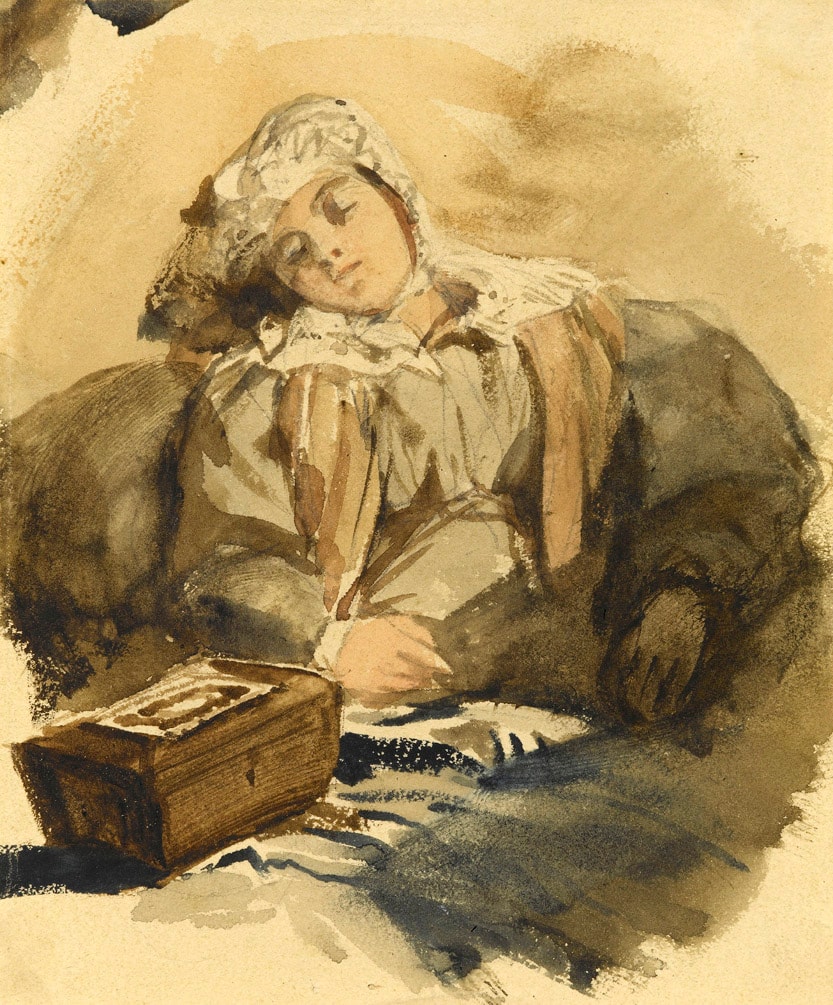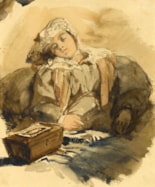Richard Parkes BONINGTON
(Arnold 1802 - London 1828)
A Young Woman Asleep
Sold
Watercolour, over an underdrawing in pencil.
A sketch of a young girl in pencil on the verso.
133 x 110 mm. (5 1/4 x 4 3/8 in.)
A sketch of a young girl in pencil on the verso.
133 x 110 mm. (5 1/4 x 4 3/8 in.)
This charming small watercolour may be grouped with a handful of other drawings of a young woman, wearing a cap or bonnet, of around 1827-1828. These late works by Bonington include four pen and ink drawings in the collections of the National Gallery of Victoria in Melbourne, the Ashmolean Museum in Oxford and the Yale Center for British Art in New Haven, CT, as well as pencil studies of what appears to be the same sitter in the Yale Center for British Art, the Wadsworth Atheneum in Hartford, CT., and a private collection in Paris.
Patrick Noon has noted that ‘The woman in these drawings was undoubtedly more than a casual acquaintance or professional model, since she sat for the artist in different contemporary dresses and several of the sketches appear to be portraits rather than pose studies. In all likelihood she was one of the artist’s friends, such as a daughter of the Rev. Edward Forster, the Protestant minister in Paris whom Bonington had befriended several years earlier.’ Some of these drawings, as well as a pen and ink drawing of a young woman in 17th century costume in the National Gallery of Art in Washington, D.C. may in turn be related to a small painting by Bonington entitled The Green Skirt or Le Billet Doux, in a private collection.
A stylistic comparison may be made with Bonington’s only extant self-portrait drawing; an equally small and intimate pen and wash study in the British Museum, datable to between 1825 and 1826. Both drawings show the particular influence of the French artists with whom Bonington was friendly in Paris, and in particular Delacroix.
Patrick Noon has noted that ‘The woman in these drawings was undoubtedly more than a casual acquaintance or professional model, since she sat for the artist in different contemporary dresses and several of the sketches appear to be portraits rather than pose studies. In all likelihood she was one of the artist’s friends, such as a daughter of the Rev. Edward Forster, the Protestant minister in Paris whom Bonington had befriended several years earlier.’ Some of these drawings, as well as a pen and ink drawing of a young woman in 17th century costume in the National Gallery of Art in Washington, D.C. may in turn be related to a small painting by Bonington entitled The Green Skirt or Le Billet Doux, in a private collection.
A stylistic comparison may be made with Bonington’s only extant self-portrait drawing; an equally small and intimate pen and wash study in the British Museum, datable to between 1825 and 1826. Both drawings show the particular influence of the French artists with whom Bonington was friendly in Paris, and in particular Delacroix.
Despite his very brief career, Richard Parkes Bonington occupies a key role in the artistic relationship between England and France in the first quarter of the 19th century. Born in a town near Nottingham, he moved with his family to Calais in 1817. There he studied with the French artist François Louis Francia, who encouraged his interest in watercolour. The following year the young Englishman settled in Paris, where he met Eugène Delacroix, who was to become a lifelong friend, and entered the studio of Baron Gros. Two of his watercolours were exhibited at the Paris Salon in 1822, and within a few years Bonington had secured a reputation as an accomplished watercolourist, painter and lithographer. He briefly shared a studio with Delacroix in Paris, and travelled extensively throughout Northern France, as well as making sketching tours of Belgium and Italy. Working in a variety of genres, including landscapes and marine subjects as well as historical and literary themes, Bonington exhibited in Paris and London. Severely weakened by tuberculosis over the last year of his life, he nevertheless continued to work until his death in September 1828, shortly before his twenty-sixth birthday.
Much of Bonington’s finest work is in watercolour, and he is today regarded as one of the masters of the medium. As one modern scholar has written, ‘Technically, he seems to have possessed from the start all the resources that gave his water-colours their particular clarity and brilliance. He knew, for example, how to use the paper surface to vary the texture of his washes…And, in his final years, he devised a method of glazing his water-colour shadows with a film of gum which gave them an added liquidity and depth.’
The influence of Bonington’s watercolour technique on later artists working in England and France, including Delacroix, Turner and Corot, is readily evident. Many years after Bonington’s death, Eugène Delacroix recalled of him: ‘To my mind, one can find in other modern artists qualities of strength and of precision in rendering that are superior to those in Bonington’s pictures, but no one in this modern school, and perhaps even before, has possessed that lightness of touch which, especially in watercolours, makes his works a type of diamond that flatters and ravishes the eye, independently of any subject and any imitation.’
Provenance
Anonymous sale, London, Christie’s, 9 November 1999, lot 38.
Literature
Patrick Noon, Richard Parkes Bonington: the complete paintings, New Haven and London, 2008, p.410, no.383a (where dated c.1827-1828); Peter Forster and Rebecca Krämer, ed., Delacroix - Courbet - Ribot: Positionen französischer Kunst des 19. Jahrhunderts, exhibition catalogue, Wiesbaden, 2017-2018, p.87, no.45.
Exhibition
Little Rock, Arkansas Art Center, 2002 Collector’s Show, no.57; Wiesbaden, Museum Wiesbaden, Delacroix - Courbet - Ribot: Positionen französischer Kunst des 19. Jahrhunderts, exhibition catalogue, Wiesbaden, 2017-2018, no.45.




